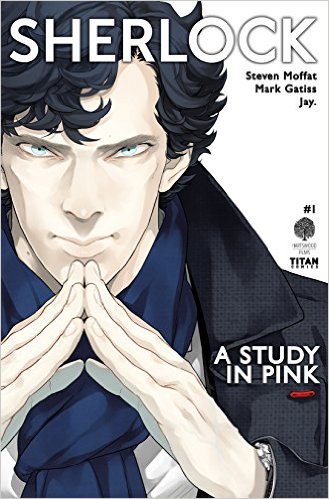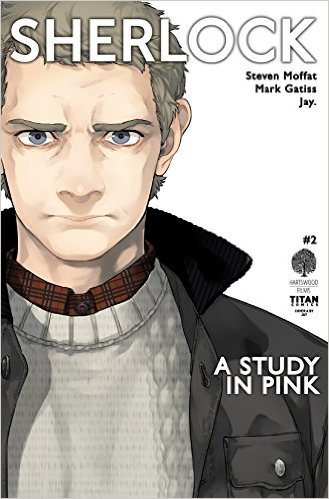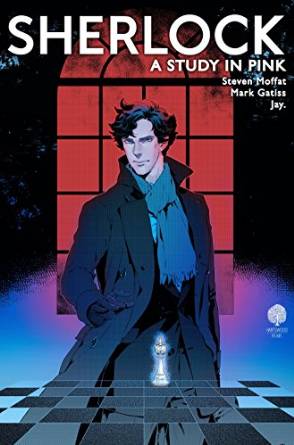Sherlock, the Manga
August 8, 2016 · 1 comment
By Andrew Osmond.
 “You may marry him, murder him, or do what you like with him.” So declared Sir Arthur Conan Doyle, the creator of Sherlock Holmes, when actor William Gillette asked if it would be acceptable to have the Great Detective fall in love in a stage play. Doyle’s comment probably reflected his weariness with Sherlock, whose popularity had come to rule the author’s reputation. Doyle would have preferred to be known for his historical novels like The White Company.
“You may marry him, murder him, or do what you like with him.” So declared Sir Arthur Conan Doyle, the creator of Sherlock Holmes, when actor William Gillette asked if it would be acceptable to have the Great Detective fall in love in a stage play. Doyle’s comment probably reflected his weariness with Sherlock, whose popularity had come to rule the author’s reputation. Doyle would have preferred to be known for his historical novels like The White Company.
A century later, Doyle’s words still animate the character. People, indeed, do whatever they like with Sherlock, who’s become one of the busiest, most multitudinous, fictional heroes in the world. Examples just from recent weeks include a new multiplatform game, Sherlock Holmes: The Devil’s Daughter, with extensive mocap animation; a London stage play, Sherlock Holmes and the Invisible Thing; and an endless stream of books with titles like Warlock Holmes – A Study in Brimstone and alt.Sherlock Holmes – New Visions of the Great Detective.
Holmes is especially active in Japan, where the stories were first translated in 1894, less than a decade after his British debut. Japan devours detective and mystery fiction as eagerly as it does images of slender, long-limbed men with penetrating gazes and intimate male relationships. Sherlock’s not always a man in Japan, though. He’s been turned into dogs – both in the Sherlock Hound 1980s anime, involving a young Hayao Miyazaki (amusingly mashed up here), and in the manga Sherlock Bones, which reincarnates the detective as a crime-solving pooch. Sherlock is also a puppet, in a recent NHK TV series where he’s voiced by famed actor Koichi Yamadera (Spike in Cowboy Bebop). In this puppet version, Holmes and Watson are teenagers at London’s Beeton boarding school – Holmes fans should get the joke. You can marvel at the first episode here.
There are inevitably a bevy of cute-girl Sherlocks, including Young Miss Holmes, a manga about the detective’s niece, and the terrifyingly-named Tantei Opera Milky Holmes, about four bumbling girl sleuths. Often there’s no need to have “Holmes” in the title. The Goth Lolita girl detective in Gosick (called Victorique) is quite patently a Sherlock substitute. So is the great boy detective L in Death Note – who has Light as his Moriarty – and the pint-sized Detective Conan, whose name is filched from Sherlock’s creator.
 Other Japanese Sherlocks include the one who fights the master thief Arsene Lupin (or “Lupin the First”) in the 1981 anime Lupin versus Holmes; or the one who meets an ancestor of Ace Attorney Phoenix Wright in the Nintendo game Great Turnabout Trial: The Adventures of Ryunosuke Naruhodo; or another new game whose trailer seems actionably close to the BBC Sherlock. It’s also worth noting the aged Holmes’ journey to a bomb-blasted Hiroshima in the recent Mr. Holmes, featuring Ian McKellen.
Other Japanese Sherlocks include the one who fights the master thief Arsene Lupin (or “Lupin the First”) in the 1981 anime Lupin versus Holmes; or the one who meets an ancestor of Ace Attorney Phoenix Wright in the Nintendo game Great Turnabout Trial: The Adventures of Ryunosuke Naruhodo; or another new game whose trailer seems actionably close to the BBC Sherlock. It’s also worth noting the aged Holmes’ journey to a bomb-blasted Hiroshima in the recent Mr. Holmes, featuring Ian McKellen.
There’s even a prominent canonical nod to Japan in the Doyle stories. In “The Empty House,” Holmes mentions that in his famous duel with Moriarty above the chasm of Reichenbach Falls, he was saved by knowing “baritsu, or the Japanese system of wrestling.” In fact, there’s no such thing as “baritsu” in Japan – the word was a misspelling of “bartitsu”, a short-lived British attempt to combine judo and jujitsu. Ironically, bartitsu has been kept alive thanks to the Holmes connection – for example, the style influenced the fight choreography in the pugilistic Sherlock Holmes films featuring Robert Downey Junior.
Unlike bartitsu (or baritsu), the manga Sherlock Holmes: A Study in Pink is authentically Japanese. It was first published in the manga anthology magazine Young Ace, which often includes adaptations and tie-ins, including manga versions of Summer Wars, Wolf Children, Panty & Stocking and the later chapters of Yoshiyuki Sadamoto’s Evangelion. On the detective side, Young Ace also publishes the manga Bungo Stray Dogs, about a team of crime-fighting detectives based on real Japanese authors – it’s now an anime series by the Bones studio.
The Sherlock manga, as is obvious from a glance at the cover, is based on Sherlock, the hit BBC series created by Steven Moffat and Mark Gatiss. Both men are linked with Doctor Who – Moffat is the current Who showrunner – hence the similarities in the shows’ style, writing and characterisation. When it debuted in 2010, Sherlock’s innovation was to update Doyle’s characters and storylines to the modern day, a trick was soon duplicated by the American series Elementary. However, Sherlock arguably succeeded less because of its setting than because of its hugely popular double act of Benedict Cumberbatch as Sherlock and Martin Freeman as Watson.
 It’s Cumberbatch – his handsome features globally linked with an otter’s – who really enjoys star status in Japan. That’s illustrated by this video of his arrival in Narita airport in 2013, as well as this one from 2012. And if you want to see Sherlock well and truly baffled, watch this clip of Cumberbatch on Japanese morning TV. Interviewed by the Daily Telegraph, Cumberbatch reflected on the tendencies of parts of his fanbase, who in his words, “write stories and do manga (sic) cartoons of what they think you get up behind closed doors. Some of it’s funny. Some of it’s full-on sex.”
It’s Cumberbatch – his handsome features globally linked with an otter’s – who really enjoys star status in Japan. That’s illustrated by this video of his arrival in Narita airport in 2013, as well as this one from 2012. And if you want to see Sherlock well and truly baffled, watch this clip of Cumberbatch on Japanese morning TV. Interviewed by the Daily Telegraph, Cumberbatch reflected on the tendencies of parts of his fanbase, who in his words, “write stories and do manga (sic) cartoons of what they think you get up behind closed doors. Some of it’s funny. Some of it’s full-on sex.”
Leaving that aside, the main concern for many buyers of the Sherlock manga will still be how it portrays its central bromantic couple. Judging by the first 40-page instalment of “A Study in Pink,” it’s Martin Freeman’s Watson who gets the better deal so far. The manga convincingly presents Watson as we first saw him on screen, an ex-army doctor traumatised by his experience in Afghanistan (rendered as a page of splintered images). We see him electrified out of sleep; we see him in his daily life, grey, hangdog and rumpled; and then we see him reanimated by his meeting with Holmes, to whom he confesses the horrors he’s seen. “Want to see some more?” goads Sherlock. “Oh god, yes,” says Watson in sweet surrender.
The manga Sherlock – which for many fans really means the manga Benedict Cumberbatch – is more of an acquired taste. His face is more obviously stylised, often caricatured and not flatteringly – some frames have him creasing his features into an inelegant crooked smirk. It’s an interesting approach, and arguably valid – the whole point about this Sherlock is that he’s discomforting, unsettling, different from everyone else. But he’s not the straightforward bishonen youth that many manga readers may have expected. In fact, the manga illustrator is an enigma, identified in the credits only as “Jay.” with the full stop included as part of the name.
The manga fails to convey the charisma of Cumberbatch’s presence… and yet it does feel true to the spirit of the character. And this is a very close translation of the TV show (it’s based on the opening 90-minute episode, which was also called “A Study in Pink.”) It follows the script pretty much to the letter, like a scrupulously faithful prose novelisation. “A Study in Pink” is one of the best Sherlock episodes; it’s the one with the string of London suicides by poison pill, a solid mystery/character story without the smug archness and silly contrivances of many later stories. However, given that Sherlock fans can easily purchase the TV episode itself, the manga’s main interest is in how it translates the story from one medium to another.
The answer is very capably, though with few surprises beyond the handling of the title character. The art is crisp, the layout easy to follow, starting with a sequence intercutting between the moments before three deaths, and the police conferences recapping them. Backgrounds are lightly but skilfully detailed – the big exception being the reveal of Sherlock’s cluttered new lodgings, which Watson wrongly assumes are waiting to be cleared. For me, one of the oddest moments of déjà vu in the manga was a sequence where Sherlock is shown beating a corpse to investigate post-mortem bruising. This gruesome detail is true to the Doyle stories, but when we see Sherlock perform the act in strip form, it reminded me disturbingly of the Joker’s violent killing of Jason Todd (the unluckiest Robin) in the Batman strip A Death in the Family.
In Japan, “Jay.” has followed his adaptation of “A Study in Pink” with the next two Sherlock TV stories, “The Blind Banker” and “The Greatest Game” (which introduced Sherlock’s nemesis Moriarty). On the basis of this first translated issue, the manga is a classy, faithful rendering of a series that’s bridged East and West in popularity – though it’s hardly the most startling of Sherlock’s guises in Japan.
Sherlock: A Study in Pink parts 1-3, is now available from Titan Books in paperback and Kindle editions.
glenda vick
June 29, 2019 3:56 pm
I love these so much. I hope I can get all the rest of the episodes in manga!